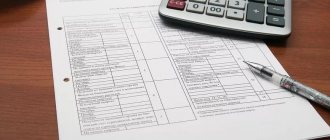Who uses accounts receivable and payable and when?
Accounts for settlements with debtors and creditors are an integral set of accounts for any company, since its functioning is impossible without:
- accrual and payment of wages and other payments to their employees (the appearance of debit and credit turnover on account 70);
- fulfillment of tax obligations (the emergence of a debit and credit balance on accounts 68 and 69);
- carrying out settlements with their counterparties (turnovers and balances on settlement accounts: 60,62,76);
It is impossible to organize full-fledged accounting without these accounts. Accounting for them must be maintained continuously in chronological order throughout the entire period of the company’s activities.
ATTENTION! In accounting, any overdue debt is considered doubtful (clause 70 of the Accounting Regulations No. 34n). You are required to create a reserve for such debts.
Check whether you have correctly determined the amount of the reserve for doubtful debts in accounting and tax accounting, using a ready-made solution from ConsultantPlus. If you do not have access to the K+ system, get a trial demo access. It's free.
Which accounting accounts are used by budgetary organizations for settlements with debtors and creditors, see the material “Creating a chart of accounts for budgetary accounting - sample.”
Postings for writing off accounts receivable
The creation of the reserve is reflected in the credit of account 63 “Provisions for doubtful debts” and the debit of account 91 “Other income and expenses”.
Writing off the debt from the reserve is a posting to the debit of account 63 and the credit of account 62 “Settlements with buyers and customers” (or the credit of account 76 or 60).
Example 4
As of June 30, 2022, the balance sheet of Luchik LLC included doubtful debts for settlements with customers in the amount of 280 thousand rubles. The accountant created a reserve and made the following posting:
DEBIT 91 CREDIT 63
— 280,000 rub. — overdue debts are included in the reserve;
In July 2022, part of the debt in the amount of 50 thousand rubles. became hopeless. Wiring appeared:
DEBIT 63 CREDIT 62
— 50,000 rub. — bad debt is written off against the reserve.
In which section of the balance sheet are accounts receivable reflected?
Accounts receivable in the balance sheet are reflected in section II “Current assets” on line 1230 “Accounts receivable”.
To complete this balance sheet line, you need to collect information from different accounting accounts and apply the following formula:
p. 1230 = DS (count 60 + count 62 + count 68 + count 69 + count 70 + count 71 + count 73 + count 75 + count 76) − KS count. 63,
where DS and KS are the debit and credit balances of the accounts on which receivables are reflected.
If you have access to ConsultantPlus, find out how to assess the solvency of a counterparty based on the balance sheet. If you don't have access, get a free trial of online legal access.
How international standards require accounting for receivables, see the material “Accounting for receivables under IFRS”.
Certain types of debtors' debts may be reflected in the balance sheet in other lines - more on this later.
Types of accounts receivable
Receivables are divided into types according to several criteria.
- By maturity date. Short-term - which will be repaid within a year, and long-term - which will be repaid over a year.
- According to the deadlines for fulfilling the obligation. Standard - the repayment period for which has not yet arrived, and overdue - for which there is a delay.
- By type of debtors. These could be buyers, suppliers, government, personnel, etc. The accounting account on which the debt will be reflected depends on the debtor. We'll tell you below.
Short-term and long-term accounts receivable: how to divide and why to do it
The division of assets by maturity is of great importance for the financial analysis of the company's performance.
How to analyze the balance sheet, see the material “Methodology for analyzing the balance sheet of an enterprise.”
The procedure for such division is simple (clause 19 of PBU 4/99 “Accounting statements of an organization”, approved by order of the Ministry of Finance of Russia dated July 6, 1999 No. 43n):
- assets are short-term if their circulation (repayment) period does not exceed 12 months. after the reporting date or the duration of the operating cycle (if it is more than 12 months);
- all other assets are classified as long-term.
Long-term and short-term receivables are not distinguished in the balance sheet; their breakdown by timing is provided in the notes to the balance sheet.
In the general case, all receivables are considered a highly liquid (highly circulating) asset, and therefore a single place is assigned to it in Section II “Current assets”. In fact, not all debtors' debts are equal in liquidity. For example, prepayments (advances issued) made by a company in connection with capital construction have low liquidity and, according to the recommendations of the Ministry of Finance of the Russian Federation (letter dated April 11, 2011 No. 07-02-06/42), they must be reflected in the balance sheet as part of non-current assets in the line "Construction in progress".
When accounts receivable are reflected in line 1170 “Financial investments” of the balance sheet, you can find out by reading our material to the end.
Doubtful and bad receivables
doubtful until the payment period has expired. If there is no specific date in the agreement with the counterparty, then it is determined subjectively based on the nature and content of similar transactions. In addition, a debt can be recognized as doubtful not only based on the date, but when information about the financial difficulties of the counterparty was published in the media or other sources. As soon as suspicions arise that a receivable may become dubious, accounting begins to form reserves for it.
hopeless when the company has no chance of repaying it. This happens in two cases:
- The statute of limitations has expired . The period is calculated from the date when the delay began from the date of fulfillment of obligations by the debtor. The maximum period is 3 years.
- The obligation cannot be fulfilled . For example, a company was declared bankrupt and excluded from the register of legal entities. But if the debtor is an individual entrepreneur, then even after deregistration he continues to be liable for debts with his property. The individual entrepreneur's debt will be considered uncollectible if he begins personal bankruptcy proceedings and the bailiffs will have nothing to collect debts from.
Very rarely does a receivable immediately become uncollectible. Usually the process starts with doubt. The company decides how to form a reserve for doubtful debts after conducting an inventory.
What is included in accounts receivable
The composition of accounts receivable in a condensed form can be presented as follows:
- debts to the company from counterparties, borrowers, employees, etc.;
- overpaid taxes, fees, insurance premiums;
- debts of the founders on contributions to the authorized capital;
- advances issued;
- fines, penalties and penalties recognized by debtors (or by court decision).
In expanded form, each enlarged group can be detailed by element. For example:
- accounts receivable from counterparties include debts of suppliers and contractors (for unpaid advances), buyers and customers (for goods and products supplied);
- employees may owe their company for amounts owed, for loans issued, for unearned but received wages, etc.
The volumes and types of receivables in a particular company depend on the specifics and scale of its activities, financial policies, schemes for working with debtors and other factors.
Which account should accounts receivable not be reflected in?
Accounts receivable cannot be reflected in accounting accounts (for example):
- fixed assets and intangible assets - 01, 04;
- depreciation - 02, 05;
- inventory assets (inventory, goods, products) - 10, 15, 16, 41, 43, 45;
- cash - 50, 51, 52, 55;
- costs, income and expenses (for production, for sale, other income and expenses) - 20, 23, 25, 26, 44, 91.
In order not to make mistakes in using accounts to account for accounts receivable, it is necessary to correctly formulate a working chart of accounts and thoroughly have information about the purpose of each account used.
Find out more about the chart of accounts for 2022 - see the material.
What can you learn from the balance sheet about accounts payable?
Line 1520 “Accounts payable” is located in section V “Short-term liabilities” of the balance sheet. Large companies add lines to the balance sheet to decipher accounts payable by type. For example:
- line 1521 - debts to counterparties;
- line 1522 - debt on taxes and fees;
- line 1523 - underpaid insurance premiums;
- line 1524 - accrued but not paid wages, etc.
Separate details of the company's accounts payable are given outside the balance sheet lines, in explanations and transcripts to the balance sheet.
For detailed information on the composition and accounting nuances of accounts payable, see the material “How are accounts payable reflected in the accounts?”
What is an enterprise's accounts payable in simple words?
Accounts payable is the debt of an enterprise to external counterparties, the budget and extra-budgetary funds, as well as employees of the enterprise.
Accounts payable arises if an enterprise received goods, work or services, entered them into accounting, but did not fulfill its payment obligations. Debt to creditors can be current or overdue, depending on the right to defer payment and the date the debt arose.
So, for example, wages are accrued in accounting on the last day of the month and paid at the beginning of the next month. At the end of the accrual month, payables to employees of the enterprise for the payment of wages will be current. In case of non-payment of wages on time, such debt will be considered overdue.
Let's consider how debtors and creditors are reflected in the financial statements of an enterprise.
Purchase of receivables: conditions and postings (to which account to attribute)
Accounts receivable may appear on the company's accounts as a result of assignment - transfer of the right to claim the debt.
Any business entity has the right to acquire the debt of a third party. The main purpose of such a purchase is to benefit from the transaction (buy cheaper and collect (or offset) the face value of the debt).
The purchase process occurs under the following conditions:
- an assignment agreement is concluded between the parties to the agreement;
- the contract requires notarization if the debt arose from a transaction completed in notarial form;
- the transfer of rights to property subject to mandatory state registration to a new creditor is subject to state registration;
- the debtor must be informed about the transfer of the right to claim the debt - this responsibility lies with the original creditor;
- After completing a debt purchase transaction, it is better to receive all documents confirming the debt from the original creditor using the transfer and acceptance certificate.
For situations that require the execution of a transfer and acceptance certificate, please use the materials posted on our website:
- “Act of acceptance and transfer of documents upon change of director”;
- “Act of acceptance and transfer of affairs of the chief accountant - sample”.
Accounting entry for accounting for receivables purchased from the original creditor (clause 3 of PBU 19/02 “Accounting for financial investments”, approved by order of the Ministry of Finance of the Russian Federation dated December 10, 2002 No. 126n):
Dt 58 “Financial investments” Kt 76 “Settlements with various debtors and creditors”
When reflecting acquired debt as part of financial investments, a number of conditions must be met - learn about this in the next section.
Acquiring debt: accounting nuances
When reflecting the acquisition in accounting, the buyer of debt must:
- check whether the acquired right to claim the debt meets the criteria for a financial investment;
- correctly form its initial amount.
To recognize a financial investment, the acquired receivables must be:
- potentially beneficial to its buyer - it can generate income;
- documented.
In addition, all financial risks (insolvency of the debtor, changes in the value of the debt, etc.) must be transferred to the buyer of the debt.
In order to reflect the purchased debt in accounting in a reliable estimate, it is necessary to correctly formulate its initial cost, calculated according to the formula (clauses 8–9 of PBU 19/02):
PSfv = FZ + KS + PS + PZ,
Where:
PSFv - the initial cost of the financial investment;
FZ - actual costs under the assignment agreement;
KS and PS - the cost of consulting, information and intermediary services related to the acquisition of receivables;
PP - other (other) costs associated with the acquisition of debt.
Find out the scheme for calculating the initial cost of various assets from the materials prepared by specialists on our website:
- “The initial cost of intangible assets is...”;
- “Accounting for fixed assets worth up to 100,000 rubles”.
In what cases should a debtor be written off?
There are legitimate reasons to write off debt. They are confirmed by documents from third-party organizations. These papers are the basis for entries in BU and NU.
How to recognize receivables as uncollectible and take them into account for income tax purposes?
Causes:
- The statute of limitations has expired. This means that the company cannot file a lawsuit for debt collection, since 3 years have passed since the organization learned of a violation of contractual obligations by the counterparty: for example, it received a refusal to pay for goods, work, or services after delivery under the contract. The period is interrupted if the organization files a lawsuit or the debtor confirms in writing the existence of obligations to the organization (Civil Code of the Russian Federation, Art. 196-1, Art. 200, Art. 203).
- The government agency signed an act on the impossibility of collection. This refers to the act of the bailiff as the basis for writing off the debt. Despite individual attempts by local Federal Tax Service officials to challenge this basis for write-off, the Tax Code of the Russian Federation and judicial practice indicate its legality (Article 266-2 of the Tax Code of the Russian Federation, Op. VAS No. 2727/08 on case No. A60-3260/2007-C6 from 02/07/08).
- The debtor organization ceased to exist as a legal entity. The basis for write-off will be an entry in the Unified State Register of Legal Entities in relation to the debtor (Article 63–9 of the Civil Code of the Russian Federation).
How to write off unrecoverable (bad) receivables in accounting?
On a note! On similar grounds, debts to creditors can be written off.
Accounts receivable can also be written off due to the impossibility of collecting them, as assessed by specialists from the company itself. This option is applicable if the economic analysis revealed that going to court is inappropriate. Usually in such cases we are talking about small volumes of receivables, compared to significant legal costs in the future (see letters of the Ministry of Finance No. 03-03-06/1/3 dated 13-01-09, No. 03-03-06 /1/124 dated 02/21/08, determined by the Supreme Arbitration Court of the Russian Federation No. 9473/08 dated 07/30/08, FAS MO No. KA-A40/13269-08-P-2 dated 02/02/09 g. and a number of similar ones).
Results
To account for settlements with debtors and creditors, various accounts are used: account 60 or 62 - if the company’s counterparties owe it for goods supplied or have not worked out the advance payment, account 71 - if employees have not reported on accountable amounts or the company has not reimbursed their personal expenses spent on its needs funds, account 68 - if there are overpayments or tax debts, etc.
If receivables were acquired under an assignment agreement, they are reflected on account 58 if, according to the criteria, they correspond to the concept of a financial investment.
You can find more complete information on the topic in ConsultantPlus. Free trial access to the system for 2 days.






